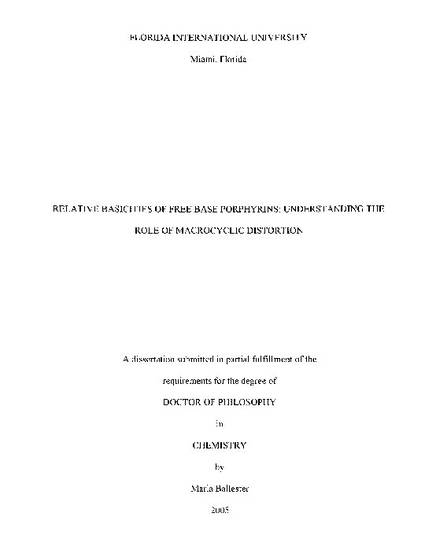
Porphyrins have been the center of numerous investigations in different areas of chemistry, geochemistry, and the life sciences. In nature the conformation of the porphyrin macrocycle varies, depending on the function of its apoenzyme. It is believed that the conformation of the porphyrin ring is necessary for the enzyme to achieve its function and modify its reactivity. It is important to understand how the conformation of the porphyrin ring will influence its properties.
In synthetic porphyrins particular conformations and ring deformations can be achieved by peripheral substitution, metallation, core substitution, and core protonation among other alterations of the macrocycle. The macrocyclic distortions will affect the ring current, the ability of pyrroles to intramolecularly hydrogen bond and the relative basicity of each of the porphyrins. To understand these effects different theoretical models are used. The ground state structure of each of 19 free base porphyrins is determined using molecular mechanics (MM+) and semiempirical methods (PM3). The energetics of deformation of the macrocyclic core is calculated by carrying out single point energy calculations for the conformation achieved by each synthetic compound. Enthalpies of solution and enthalpies of protonation of 10 porphyrins with varying degrees of macrocyclic deformation and varying electron withdrawing groups in the periphery are determined using solution calorimetry. Using Hess's Law, the relative basicity of each of the different free base porphyrins is calculated. NMR results are described, including the determination of free energies of activation of ring tautomerization and hydrogen bonding for several compounds. It was found that in the absence of electronic effects, the greater macrocyclic deformation, the greater the basicity of the porphyrins. This basicity is attenuated by the presence of electron withdrawing groups and ability to of the macrocycle to intramolecularly hydrogen bond.
Available at: http://works.bepress.com/maria-ballester/2/

If you are the rightful copyright holder of this dissertation or thesis and wish to have it removed from the Open Access Collection, please submit a request to dcc@fiu.edu and include clear identification of the work, preferably with URL.